Heating pipes in the wall: how to heat the room without
Many owners of private houses, trying to give the premises a more attractive appearance, hide the pipes of the heating system, leaving only radiators visible. But few people know that you can get rid of this equipment by equipping the wall heating of the house. Instructions on how to completely disguise the climate network are outlined below.
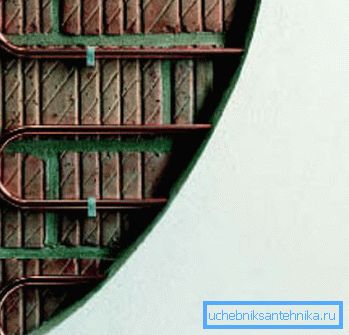
Heated walls - a new way of space heating
Basic concepts
Any modern repair provides for masking pipelines that supply heated coolant to radiators and divert cooled water from them. But many owners are not satisfied with the batteries themselves, which contribute to the dissonance of various interior solutions.
In this case, you can apply already well-proven solutions, which, however, are not without drawbacks:
- warm floor system - it is not effective enough in large areas or rooms where the floor is covered with a material having a low thermal conductivity (for example, wood);
- infrared ceiling heating - can be mounted in dwellings with a ceiling height of at least 2.5 meters and during operation uses a large amount of electricity.
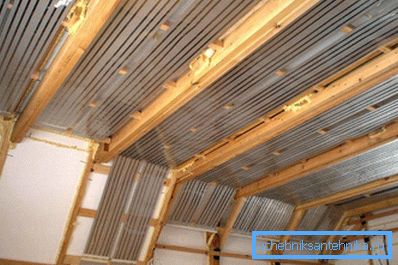
Therefore, recently a heating scheme called “warm walls” is becoming more and more common.
Its features are as follows:
- in this case, heat sources are not radiators: the heating pipes are laid in the wall, through which the coolant circulates, radiating thermal energy into the surrounding space;
- due to the fact that heating takes place with the help of radiation, and not as a result of convection, a better heating of the room is achieved and a healthy atmosphere is created in it;
- heating in the walls makes it possible to achieve significant savings in energy costs, since even at a temperature of 17-18 degrees Celsius, the room becomes comfortable (for comparison, with the standard heating method it is necessary to reach 21-22 degrees Celsius).
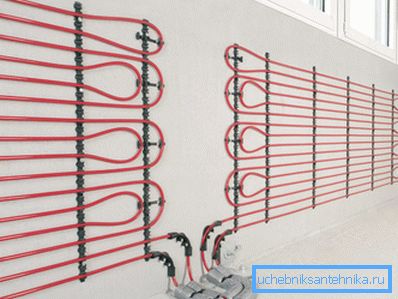
Note! Installation of heating pipelines in the walls is a rather laborious task. Therefore, you can hardly do everything yourself without the necessary skills and experience. It is better to entrust this work to professionals.
Advantages of wall heating scheme
In addition to the above features, the system of heating walls has many undeniable advantages:
- There are no restrictions on the development and implementation of any design decisions. Bulky heating radiators installed under the windows will no longer interfere. This space can be used more effectively.
- Due to the huge area of radiation of thermal energy (the source is almost all the walls in the room), the room warms up more evenly, eliminating the formation of local zones of cold and overheated air.
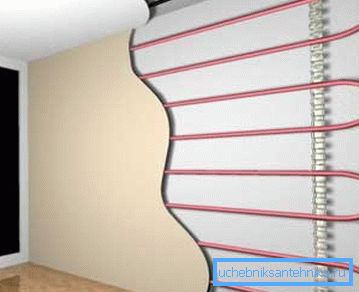
Tip! To improve heat transfer, aluminum heat exchangers can be installed under the plaster. In addition to increasing efficiency, they make it possible to use fewer pipes.
- A room with warm walls becomes more comfortable, since not only the lonely battery under the window becomes the heat source, but the whole room as a whole.
- With pipes installed in the wall, you can not only heat, but also cool the room. To do this, the system is fed unheated coolant and cooled water. This way you can reduce the cost of air conditioning.
Features of implementation and operation
In order for the pipes hidden in the walls to heat the rooms as efficiently as possible, you need to think in advance about the layout of the furniture.
Should take into account such nuances:
- Freestanding furniture is not a problem. It is always placed not close to the wall and therefore an air gap is always formed between it and the vertical surface, sufficient for the warm air to freely circulate around the room.
- Built-in furniture, as the name implies, is mounted on a specific location. Consequently, the wall behind such a cabinet should be free from pipelines: first, they will heat the furniture and everything inside it, secondly, it will be inefficient to use thermal energy, increasing heating costs.

The wall heating system is completely invisible, as the pipes are laid under a decorative finish. In this regard, many people have a question: how to drill a hole or drive a nail in order not to touch the pipeline that conducts heat transfer fluid.
The designers of similar engineering networks have already taken care of this, having provided two rather effective ways:
- Use paper matrix. In this case, special rolls of paper or plastic film are applied on a natural scale to place all the pipelines. Subsequently, if it becomes necessary to make a hole, you just need to attach the matrix to the walls and see where you can drill and where you cannot.
- The use of thermal film. This is a special material that changes color in places with high temperatures. Attaching it to the surface of the wall, you will see with maximum precision where the pipelines pass.
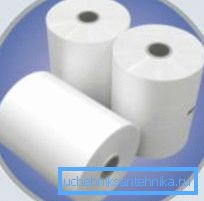
Disadvantages and ways to deal with them
The wall heating system is undoubtedly very effective. But during its installation it is necessary to solve several very important engineering issues that directly affect the durability, efficiency and cost-effectiveness of its operation.
Linear expansion tubes
Any material, as you know from the school course of physics, expands when heated, that is, its size increases. This applies both to pipes laid in the wall and to the plaster with which they are disguised.
If you leave this problem without attention, the appearance of cracks in the wall and the deformation of the plastic channels is possible, which will lead to disruption of fluid circulation.
You can resolve the issue as follows:
- Lower the temperature of the coolant. In most cases, the water used for wall heating is heated to a temperature not exceeding 40 degrees Celsius.
- To create the described design, it is advisable to purchase materials that have a minimum coefficient of thermal expansion (for example, metal-plastic or cross-linked polyethylene). Although the price of such pipes is somewhat higher, the benefits obtained will not make you regret the decision made.
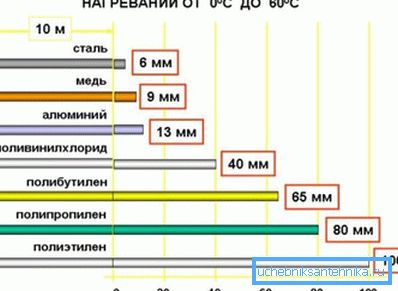
- It is necessary to cover pipes with building mixtures, in which plasticizers are added, which increase elasticity. In this case, even with small movements of the base, the appearance of cracks is completely excluded.
Heat loss
The essence of the problem is that the heat energy from the pipes located in the wall will spread both inside and outside. To avoid this situation is quite simple: it is necessary to protect the external surface with heat insulating material: foam, mineral fiber, and so on.
Tip! The best result can be achieved if you use insulators with a reflective layer - metal or aluminum foil.
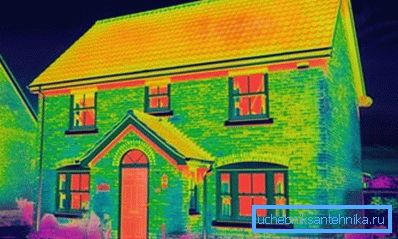
Naturally, if the house is made by frame technology or from ready-made multi-layer panels, additional insulation is not required. Such materials are initially well insulated from the outside and will not allow heat loss.
Sometimes the ability of wall heating to radiate energy in both directions can be turned from a disadvantage to an advantage: if the pipes are installed in an interior partition, both rooms will be heated.
Maintainability
The greatest danger that the owner of the house can face with wall heating is the loss of tightness of the pipeline embedded in the wall.
To prevent this trouble from happening to you, it is recommended to adhere to the following tips during installation:
- only pipes (polyethylene or metal-plastic) should be immured into concrete - the fittings of the heating system pipes, valves and other parts are mounted by the open method;
- collectors and control equipment must be installed in a special cabinet so you can easily change the operating parameters of the entire heating system from one place and eliminate possible accidents.
Conclusion
The “warm walls” system is one of the most promising technologies in the field of designing climate systems. However, it is far from the only possible option. You can learn more about alternative heating methods from the video below.